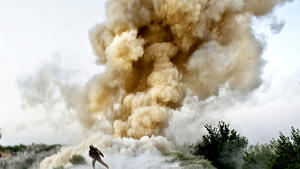Mexico: descent into chaosFBI, ATF aid in inquiry of Mexico's first IED attack
Car bombs have been used by terrorists and guerrilla groups in the Middle East, Ireland, Spain, and Colombia — but, until last Thursday, not in Mexico; the Juárez bombing involved an elaborate scheme — the perpetrators dressed a man in a police uniform and laid him on the ground to lure others to the body; the explosion occurred right after a paramedic and a federal agent approached the body; the bombing was part of a brutal war drug cartels have been waging to control the Chihuahua state drug smuggling corridor that has claimed more than 1,500 lives so far this year

Improvised Explosive Devices, such as this one detonated in Afghanistan, have found their way into the Mexican drug wars // Source: wsj.com
Experts with the FBI and the U.S. Bureau of Alcohol, Tobacco, Firearms and Explosives are helping Mexican authorities with their investigation of the 15 July car bombing in Juárez that killed three people. “The FBI sent a small team to the crime scene to consult with our Mexican counterparts and we have offered them technical assistance with the car bombing,” El Paso FBI Special Agent Andrea Simmons said Sunday. “We would only be involved if the Mexican government asked for our assistance in some way.”
The ATF is also assisting, said Tom Crowley, a spokesman for the agency in Dallas. “The ATF is providing Mexican officials with help on the technical aspects of the bomb,” Crowley said. “We have provided post-lab training to Mexican law enforcement in the past. It is the same kind of training we give to state and local police in the United States. “Post-lab involves reconstructing the device used in the explosion so investigators can determine what it was and where it might have come from.”
The El Paso Times’s By Diana Washington Valdez writes that Mexican officials attributed last Thursday’s deadly attack to enforcers of the Carrillo Fuentes drug cartel. They said the bombing took place because police had arrested Jesus Armando Acosta Guerrero, 35, a lieutenant in the cartel.
Acosta was arrested in Juárez last year in connection with the 4 November shooting at the Amadeus club that killed six men, including U.S. Air Force Staff Sgt. David Booher of Holloman Air Force Base.
Mexican officials did not say why Acosta was released before his second arrest on 15 July before the bombing.
Military officials said a C-4 plastic explosive was used in the car bomb, and apparently was set off remotely with a cell phone.
Car bombs have been used by terrorists and guerrilla groups in the Middle East, Ireland, Spain, and Colombia — but, until last week, not in Mexico.
The Juárez bombing involved an elaborate scheme. Officials said the perpetrators dressed a man in a police uniform and laid him on the ground to lure others to the body.
The explosion occurred right after a paramedic and a federal agent approached the body.
Luis Hernandez, a cameraman for Channel 5 in Juárez, was injured in the attack. He filmed the scene before the explosion, and continued running his camera after he was hurt.
The Carrillo Fuentes and Joaquin “Chapo” Guzman cartels have been waging a brutal battle to control the Chihuahua state drug smuggling corridor that has claimed more than 1,500 lives so far this year.
On Sunday, the Mexican Public Safety Secretary’s Office announced that between 1 December 2006 and 16 July 2010, it had detained 1,626 people with organized crime groups involved in drug-trafficking and kidnappings. The agency provided the following breakdown for detentions by cartel:
Sinaloa or Guzman cartel, 304 leaders detained
Gulf cartel (Zetas), 622 leaders detained
Tijuana cartel, 65 leaders detained
The Familia Michoacana cartel, 517 leaders detained
Carrillo Fuentes cartel, 84 leaders detained
